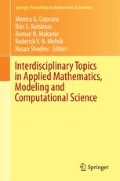Abstract
Air Health Indicator (AHI) is a joint Health Canada/Environment Canada initiative. A component in the indicator is an estimate of the time-dependent population health risk due to short-term (acute) effects of air pollution. The standard approach for this risk estimation uses a generalized additive model (GAM) framework, which includes one or more air pollutants and one or more temperature terms as covariates, as well as a smooth function of time. In this risk-modeling framework, the temperature is not the primary focus, but is included to ensure that common structure between the mortality (response), the pollutant(s), and the temperature is not included in the risk attribution.
We examine the smooth function link that is commonly used when including temperature. We show that for a single lag of temperature, the traditional J-, U-, or V-shaped relationship between temperature and mortality is largely a function of low-frequency mortality structure and is thus accounted for by the smooth function of time typically included in risk models. We further compare and contrast the first two primary lags of temperature in the context of these findings, and demonstrate differences in their structure, advocating the inclusion of only the first (lag-0) parametric temperature series in the model.
Access this chapter
Tax calculation will be finalised at checkout
Purchases are for personal use only
References
Barnett, A.G., Tong, S., Clements, A.C.A.: What measure of temperature is the best predictor of mortality? Environ. Res. 110(6), 604–611 (2010)
Burr, W.S.: Air Pollution and Health: Time Series Tools and Analysis. PhD thesis, Queen’s University, Kingston, Ontario, Canada, October 2012
Burr, W.S., contributions from Karim Rahim: spsmooth: An Extension Package for 'mgcv`, (2012). R package version 1.0–0
Dominici, F., Samet, J.M., Zeger, S.L.: Combining evidence on air pollution and daily mortality from the 20 largest US cities: a hierarchical modelling strategy. J. Royal Stat. Soc. Series A Stat. Soc. 163(3), 263–302 (2000)
Gasparrini, A., Armstrong, B., Kenward, M.G.: Distributed lag non-linear models. Stat. Med. 29(21), 2224–2234 (2010)
Goldberg, M.S., Gasparrini, A., Armstrong, B., Valois, M.-F.: The short-term influence of temperature on daily mortality in the temperate climate of Montreal, Canada. Environ. Res. 111(6), 853–860 (2011)
Peng, R.D., Dominici, F., Louis, T.A.: Model choice in time series studies of air pollution and mortality. J. Royal Stat. Soc. Series A Stat. Soc. 169(2), 179–203 (2006)
R Core Team: R: A Language and Environment for Statistical Computing. R Foundation for Statistical Computing, Vienna, Austria, (2012). ISBN 3-900051-07–0
Samet, J., Zeger, S., Kelsall, J., Xu, J., Kalkstein, L. Does weather confound or modify the association of particulate air pollution with mortality? An analysis of the philadelphia data, 1973–1980. Environ. Res. 77(1), 9–19 (1998)
Schwartz, J., Spix, C., Touloumi, G., Bachárova, L., et al.: Methodological issues in studies of air pollution and daily counts of deaths or hospital admissions. J. Epidemiol. Community Health 50(Suppl 1), S3–11 (1996)
Slepian, D.: Prolate spheroidal wave functions, Fourier analysis, and uncertainty V: the discrete case. Bell Syst. Tech. J. 57, 1371–1429 (1978)
Wood, S.N.: Fast stable restricted maximum likelihood and marginal likelihood estimation of semiparametric generalized linear models. J. Royal Stat. Soc. Series B Stat. Methodol. 73(1), 3–36 (2011)
Acknowledgement
The authors gratefully acknowledge discussion with Professor Glen Takahara, Queen’s University, and data made available by the Air Health Indicator (AHI) project. Some content has been previously published as a part of the PhD thesis of the first author [2].
Author information
Authors and Affiliations
Corresponding author
Editor information
Editors and Affiliations
Rights and permissions
Copyright information
© 2015 Springer International Publishing Switzerland
About this paper
Cite this paper
Burr, W., Shin, H. (2015). Accounting for Temperature when Modeling Population Health Risk Due to Air Pollution. In: Cojocaru, M., Kotsireas, I., Makarov, R., Melnik, R., Shodiev, H. (eds) Interdisciplinary Topics in Applied Mathematics, Modeling and Computational Science. Springer Proceedings in Mathematics & Statistics, vol 117. Springer, Cham. https://doi.org/10.1007/978-3-319-12307-3_15
Download citation
DOI: https://doi.org/10.1007/978-3-319-12307-3_15
Published:
Publisher Name: Springer, Cham
Print ISBN: 978-3-319-12306-6
Online ISBN: 978-3-319-12307-3
eBook Packages: Mathematics and StatisticsMathematics and Statistics (R0)

